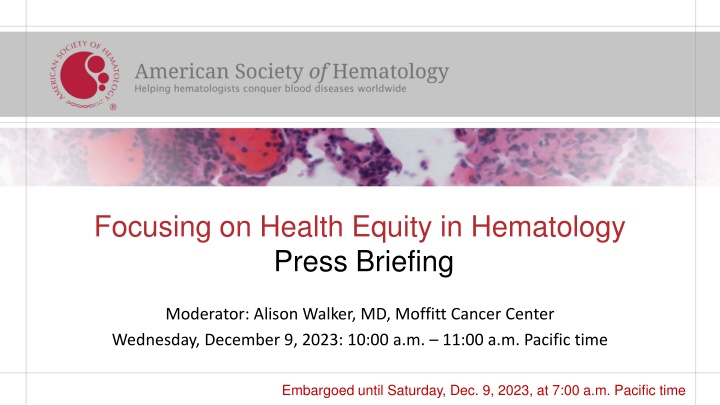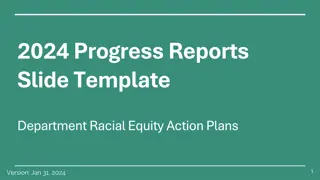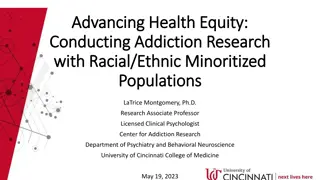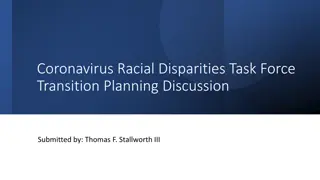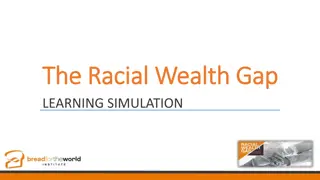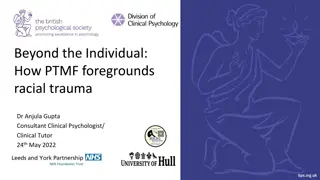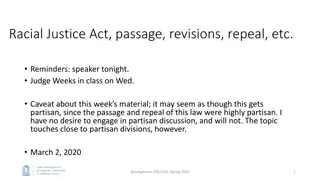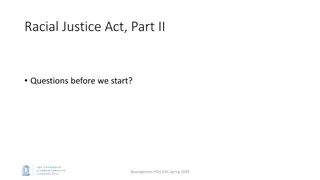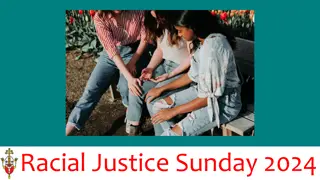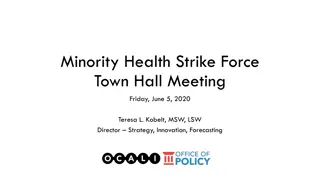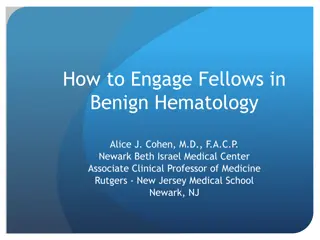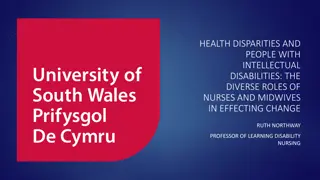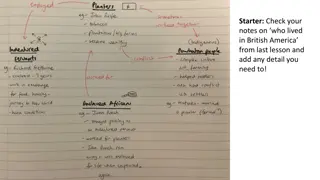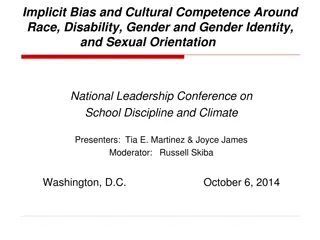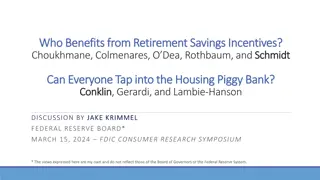Addressing Racial Disparities in Hematology: Insights and Strategies
Health equity in hematology is a critical focus area, highlighted in a press briefing with panelists discussing interventions to mitigate disparities in leukemia outcomes based on race, gender, and mental health status. Research confirms historical disparities in acute myeloid leukemia outcomes for Black patients. Treatment intensity, personalized pharmacogenetics, and funding distribution are key factors influencing outcomes in hematologic disorders.
Download Presentation

Please find below an Image/Link to download the presentation.
The content on the website is provided AS IS for your information and personal use only. It may not be sold, licensed, or shared on other websites without obtaining consent from the author.If you encounter any issues during the download, it is possible that the publisher has removed the file from their server.
You are allowed to download the files provided on this website for personal or commercial use, subject to the condition that they are used lawfully. All files are the property of their respective owners.
The content on the website is provided AS IS for your information and personal use only. It may not be sold, licensed, or shared on other websites without obtaining consent from the author.
E N D
Presentation Transcript
Focusing on Health Equity in Hematology Press Briefing Moderator: Alison Walker, MD, Moffitt Cancer Center Wednesday, December 9, 2023: 10:00 a.m. 11:00 a.m. Pacific time Embargoed until Saturday, Dec. 9, 2023, at 7:00 a.m. Pacific time
Contact ASH press staff at ashmedia@fleishman.com Panelists Jatinder Lamba, PhD, University of Florida 386: Intensification of Therapy and Pharmacogenetic Personalization Mitigate Racial Disparities in Pediatric Acute Myeloid Leukemia Outcomes Sara Khan, DO, HCA Florida Bayonet Point 5113: A 10 Year Analysis of Gender Distribution in National Institutes of Health Funding for Non- Malignant Hematology Alissa Visram, MD, MPH, Ottawa Hospital Research Institute 541: Comparison of the Efficacy in Clinical Trials Versus Effectiveness in the Real-World of Treatments for Multiple Myeloma: A Population-Based Cohort Study Michelle Lee, MD, Massachusetts General Hospital 388: Psychiatric and Substance Use Disorders Are Independent Predictors of Treatment Response and Outcomes in United States Veterans with Newly Diagnosed Acute Myeloid Leukemia Treated with Venetoclax Combinations Embargoed until Saturday, Dec. 9, 2023, at 7:00 a.m. Pacific time
Intensification of Therapy and Pharmacogenetic Personalization Mitigate Racial Disparities in Pediatric Acute Myeloid Leukemia Outcomes Jatinder K. Lamba, Richard Marrero, Huiyun Wu, Xueyuan Cao, Phani Krishna Parcha, Seth Karol, Hiroto Inaba, Dennis John Kuo, Barbara A. Degar, Kenneth Heym, Jeffrey W. Taub,Norman Lacayo, Ching-Hon Pui, Raul C. Ribeiro, Stanley B. Pounds, Jeffrey E. Rubnitz Embargoed until Saturday, Dec. 9, 2023, at 7:00 a.m. Pacific time
Racial Disparity in AML Outcome Black patients historically have poor outcome as compared to White patients. Adult AML Pediatric AML AYA AML Larkin et al, 2022 Conneely et al, 2021 Bhatnagar et al, 2022 Embargoed until Saturday, Dec. 9, 2023, at 7:00 a.m. Pacific time
AML02 cohort (N=161 White, 44 Black) AML08 cohort (N=99 White, 43 Black) AML08: AML02: HDAC Arm High dose Ara-C (3g/m2/dose every 12 hrs days 1,3 and 5) with daunorubicin and etoposide AML08: HDAC Arm High dose Ara-C with daunorubicin and etoposide AML02: Standard Arm Low dose Ara-C (100 mg/m2/dose every 12 hrs days 1-10) with daunorubicin and eto Clofarabine/Ara-C Clo 52 mg/m2 and cytarabine (1 g/m2on days 1 to 5) Compare the outcome of Black and White pediatric patients with AML treated on the multi-site St. Jude AML02 and AML08 clinical trials Compare pharmacogenomic differences between Black and White patients and its contribution to disparities in outcome Rubnitz et al, Lancet Oncology 2010; Rubnitz et al, JCO 2019 Embargoed until Saturday, Dec. 9, 2023, at 7:00 a.m. Pacific time
Survival outcomes did not differ by race by treatment arms EFS by race in Clo/Ara-C Arm EFS by race in standard Arm EFS by race in HDAC Arm Black: HR:0.75 (0.33-1.69); p=0.49 White: REF Black: HR:1.02 (0.62-1.67); p=0.95 White: REF Black: HR:1.44 (0.71-2.94); p=0.32 White: REF Embargoed until Saturday, Dec. 9, 2023, at 7:00 a.m. Pacific time
Pharmacogenomics based ACS10 score Multi-SNP combination Predictor modeling SNPs in Ara-C pathway genes Cytarabine/Ara-C ACS10 distribution by race Ara-C SNP (ACS10) Score Patient classification: LOW ACS10 HIGH ACS10 Black High ACS10 Score >0 Efficient ara-C activators Low ACS10 Score 0 Poor ara-C activators Low ACS10 score predicts lower ara-CTP levels and poor outcome 4A) EFS in AML02-LDAC arm by ACS10 Score High-ACS10 High ACS10 (n=316) White Low-ACS10 Low ACS10 (n=149) HR=2.81(1.45-5.43) P = 0.002 HR=1.64(1.21-2.22) P = 0.0016 p Elsayed et al, JCO 2022 Embargoed until Saturday, Dec. 9, 2023, at 7:00 a.m. Pacific time
Black patients with low ACS10 have poor outcome with standard therapy BUT benefit from Augmented therapy LDAC Clo/Ara-C N=15 High ACS10 (n=6) LowACS10 (n11) HDAC N=25 LDAC N=11 LDAC: ref HDAC: HR: 0.49; 95%CI (0.20-1.22); p=0.13 Clo/AraC: HR: 0.17; 95%CI (0.05-0.66); p=0.01 HDAC High ACS10 (n=8) LowACS10 (n=25) In Low ACS10 group ranking for therapy choice 1. Best Option Clo+Ara-C 2. High dose-Ara-C (HDAC) 3. Worst Option Low dose Ara-C (LDAC) Clo/Ara-C LowACS10 (n=15) High ACS10 (n=5) Embargoed until Saturday, Dec. 9, 2023, at 7:00 a.m. Pacific time
World-wide distribution of ACS10 score Impact of Cytarabine Pharmacogenomics on Survival of Adolescent and Young Adults with AML and Its Clinical Relevance in Black Patients Number: 2954, December 10 ACS10- Cytarabine Pharmacogenomics Score Impacts Survival in Pediatric AML Patients Treated on AAML1031 Trial and Associates with Outcome Differences in Black AML Patients Number: 4314, December 11 Embargoed until Saturday, Dec. 9, 2023, at 7:00 a.m. Pacific time
A 10 Year Analysis of Gender Distribution in the National Institutes of Health Funding for Non Malignant Hematology Sara Khan, DO1; Faraz Eshaghi, DO1, Aruba Sohail2, Kainat Khan3, Taha Huda, MD1; Evan Lindbergh, DO1; Kapisthalam S. Kumar, MD 4 HCA Healthcare/USF Morsani College of Medicine GME: Bayonet Point, Hudson, FL1; Dow University of Health Sciences, Karachi, Pakistan2; Edward Via College of Medicine, Auburn, AL3; Florida Cancer Specialists, Trinity FL4 Embargoed until Saturday, Dec. 9, 2023, at 7:00 a.m. Pacific time
Embargoed until Saturday, Dec. 9, 2023, at 7:00 a.m. Pacific time
Embargoed until Saturday, Dec. 9, 2023, at 7:00 a.m. Pacific time
Embargoed until Saturday, Dec. 9, 2023, at 7:00 a.m. Pacific time
National Heart, Lung, and Blood Institute (NHLBI) 2012 -Females: 664 grants awarded in non-malignant hematology -Males: 1794 grants awarded in non-malignant hematology 2022 -Females: 888 grants awarded in non-malignant hematology -Males: 1779 grants awarded in non-malignant hematology Embargoed until Saturday, Dec. 9, 2023, at 7:00 a.m. Pacific time
Conclusion This analysis highlights continued gender disparity asonly 33% of total R01 NIH grants were awarded to females during the fiscal years 2012-2022 in non-malignant hematologic research. Although, it is noted that while some agencies have made strides towards gender parity, others continue to have a significant gap. While this remains a systemic and multifaceted issue, identifying these areas of gender disparity will enable targeted efforts to bridge this gap and advance gender equality. NEXT STEPS Embargoed until Saturday, Dec. 9, 2023, at 7:00 a.m. Pacific time
Comparison of the efficacy in clinical trials versus effectiveness in the real-world of treatments for multiple myeloma: A population-based cohort study A. Visram, K. Chan, H. Seow, G. Pond, A. Gayowsky, A. McCurdy, I. Sandhu, C. Venner, G. Lancman, A. Balitsky, R. Bruins, S. Kumar, R. Fonseca, H. Mian Embargoed until Saturday, Dec. 9, 2023, at 7:00 a.m. Pacific time
Introduction Randomized control trials (RCT) are the gold standard for regulatory approval and treatment guidelines, and informing patients about expected outcomes Efficacy outcomes in an ideal RCT setting ? Effectiveness outcomes in the real worldsetting How much does the RCT efficacy differ from the real- world effectiveness for multiple myeloma therapies? Embargoed until Saturday, Dec. 9, 2023, at 7:00 a.m. Pacific time (Visram et al. ASH 2023 Abstract #541)
Study Aims In patients with newly diagnosed MM (NDMM) and relapsed- refractory MM (RRMM) treated with standard-of-care regimens in Ontario, Canada: 1. Primary aim: compare the RCT efficacyversus real-world effectivenessin Ontario, Canada, with respect to progression free survival (PFS) and overall survival (OS) 2. Secondary aim: compare the rates of serious adverse events in the RCT versus real-world setting Embargoed until Saturday, Dec. 9, 2023, at 7:00 a.m. Pacific time (Visram et al. ASH 2023 Abstract #541)
Methods Study Population Reimbursed Standard of Care (SoC) regimens in Ontario, Canada as of Dec. 31, 2020 Phase 3 RCT Transplant eligible NDMM none CyBorD-ASCT-R maintenance (cyclophosphamide & bortezomib & dex autologous transplant - lenalidomide) Real-world cohort IC/ES database Administrative healthcare claims for all Ontario residents (13 million) Loss to follow-up rate 0.25%1 Retrospectively included patients diagnosed with multiple myeloma between Jan 2007- Dec 20202 1Silver et al. JASN 2018 2Fiala et al. JCO Clin. Informatics 2017 Clinical-trial cohort Transplant ineligible NDMM RD (n=824) Published Kaplan-Meier curves for SoC regimens were digitized to provide individual patient-level PFS and OS data FIRST (Rd continuous; n=535) VRD (n=282) SWOG0777 (VRD; n=242) RRMM KD (n=498) ENDEAVOR (KD; n=464) KRD (n=287) ASPIRE (KRD; n=396) DVD (n=627) CASTOR (DVD; n=251) DRD (n=785) POLLUX (DPD; n=286) PD (n=648) MM-003 (PD; n=302) Embargoed until Saturday, Dec. 9, 2023, at 7:00 a.m. Pacific time (Visram et al. ASH 2023 Abstract #541)
Results Crude comparison of RCT and RW outcomes Median PFS Median OS Months Months -10 0 10 20 0 10 20 30 40 Rd Rd 3 20.7 VRd VRd 8.2 35.9 Kd Kd 37.9 14.8 KRd KRd 26.7 18.3 DVd DVd 23.7 7.2 DRd DRd 19.3 11.9 Pd Pd 0.1 - Added benefit in RCT patients (months) Added benefit in RCT patients (months) With the exception of the pom-dex regimen, the absolute mPFS was 3-18.3 months and mOS >19 months longer in RCT compared to real world patients Embargoed until Saturday, Dec. 9, 2023, at 7:00 a.m. Pacific time (Visram et al. ASH 2023 Abstract #541)
Results Forest plot (overall survival) Overall, the risk of death was 75% higher in real-world compared to RCT patients treated with the same SoC regimens Embargoed until Saturday, Dec. 9, 2023, at 7:00 a.m. Pacific time (Visram et al. ASH 2023 Abstract #541)
Results Forest plot (progression free survival) Overall, the risk of progression or death was 44% higher in real-world compared to RCT patients treated with the same regimen Embargoed until Saturday, Dec. 9, 2023, at 7:00 a.m. Pacific time (Visram et al. ASH 2023 Abstract #541)
Conclusion This is one of the largest population-level studies highlighting the significant efficacy-effectiveness gap with multiple standard of care regimens for multiple myeloma Real-world patients experienced a 44% worse PFS and a 75% worse OS compared to RCT patients. Underscores the importance of real-world data to understand whether RCT outcomes are generalizable to our real-world patients Our results will better inform both clinicians and patients to allow for shared treatment decision making Embargoed until Saturday, Dec. 9, 2023, at 7:00 a.m. Pacific time (Visram et al. ASH 2023 Abstract #541)
Psychiatric and Substance Use Disorders are Independent Predictors of Treatment Response and Outcomes in U.S. Veterans with Newly Diagnosed Acute Myeloid Leukemia Treated with Venetoclax Combinations Michelle H. Lee MD1,2, Jennifer La PhD3, Mary T. Brophy MD3-5, Nhan V. Do MD3,6, Camille V. Edwards MD5,6, Clark Dumontier MD, MPH2,7-9, Gabriela Hobbs MD1,2, Nathanael R. Fillmore PhD2-4 1Department of Medical Oncology, Massachusetts General Hospital, Boston, MA, 2Havard Medical School, Boston MA, 3Cooperative Studies Program Informatics Center, VA Boston Healthcare System, Boston, MA, 4VA Boston Healthcare System, Department of Medicine, Boston, MA, 5Section of Hematology and Medical Oncology, Boston Medical Center, Boston, MA, 6Boston University School of Medicine, Boston, MA, 7New England Geriatric Research, Education and Clinical Center, VA Boston Healthcare System, Boston, MA, 8Dana Farber Cancer Institute, Boston, MA, 9Division of Aging, Brigham and Women s Hospital, Boston, MA Embargoed until Saturday, Dec. 9, 2023, at 7:00 a.m. Pacific time
Background With a median age of 69 years at diagnosis, older adults represent the majority of patients with acute myeloid leukemia (AML). Venetoclax (VEN) combinations are now a frontline option for patients with newly diagnosed AML who are 75 years or <75 but deemed unable to tolerate intensive chemotherapy induction. Prior to the U.S. Food and Drug Administration (FDA) approval of VEN in 2018, AML treatment was extremely limited; over 50% of adults 65 years were not treated. Older adults carry multiple comorbidities and we do not know how they affect treatment outcomes. Veterans represent an aging population of varying wartime eras with distinct health issues. Disparities in outcomes exist between veterans with AML and clinical trial populations. AIM: To determine the prevalence and impact of psychiatric and SUDs on treatment response and outcomes of veterans with AML induced upfront with VEN. Embargoed until Saturday, Dec. 9, 2023, at 7:00 a.m. Pacific time
Results: Psychiatric and SUDs are prevalent among veterans with AML Cohort (n=452) Comorbidity N (% of 452) Psychiatric Disorders At least one diagnosis 206 (46) Anxiety 150 (33.2) Psychiatric Disorder 157 (35%) Neither 212 (47%) Bipolar Disorder 47 (10.4) Depression 144 (31.9) Other depressive/mood disorders 139 (30.8) Personality disorders 13 (2.9) Schizophrenia 5 (1.1) Schizophrenia/related psychotic disorders 9 (2.0) Both 49 (11%) Post-traumatic stress disorder 91 (20.1) SUD 34 (7.5%) SUDs At least one diagnosis 84 (19) Median age of cohort: 74 98.5% male 76% White race Alcohol use disorder 49 (10.8) Drug use disorder* 52 (11.5) ccwdata.org *includes opioid, anxiolytic, hypnotic, hallucinogen, and other non-opioid substance abuse Embargoed until Saturday, Dec. 9, 2023, at 7:00 a.m. Pacific time
Results: Psychiatric and SUDs are more prevalent in younger veterans with AML Prevalence by Age Group 100 90 80 68 70 60 % of Total 50 50 39 38 40 26 30 20 9 10 0 <65 years 65-74 years 75+ years Psychiatric Disorder SUD Embargoed until Saturday, Dec. 9, 2023, at 7:00 a.m. Pacific time
Results: VEN treatment response by Psych and SUD CCR (CR+CRi) PD HSCT post-VEN 64 Veterans with SUD had lower rates of remission (p=0.003) 57 57 No significant difference in rates of progressive AML (p=0.154) 41 38 % Within the entire cohort, 12 (3%) veterans underwent HSCT 25 15 14 13 12 Zero veterans with SUD were transplanted 5 3 2 0 0 OVERALL POPULATION, N=452 PSYCHIATRIC DISORDER, N=157 SUD, N=83 PSYCHIATRIC + SUD, N=49 NEITHER, N=212 CCR = composite complete remission, CR = complete remission, CRi = complete remission with incomplete count recovery, PD = progressive disease, HSCT = allogeneic stem cell transplantation Embargoed until Saturday, Dec. 9, 2023, at 7:00 a.m. Pacific time
Results: Incidence of ICU utilization post-induction significantly higher in SUD No SUD SUD ICU Event per 5 person-years 2.2 5 0 1 2 3 4 5 6 Relative Risk = 2.26 (1.56-3.2) p<0.001 Embargoed until Saturday, Dec. 9, 2023, at 7:00 a.m. Pacific time
Results: Early mortality (EM) rate highest among veterans with SUD 40 Within 60 days of VEN initiation, 87 (19%) veterans died 35 35 % OF COMORBIDITY GROUP 30 Only 8 veterans had refractory/progressive AML 25 23 22 19 20 15 13 EM rates lowest with neither psych/SUD; veterans with SUD had significantly higher rates (35%) of early mortality (p=0.006) 10 5 0 Overall population, n=452 Psychiatric disorder, n=157 SUD, n=83 Psychiatric + SUD, n=49 Neither, n=212 Embargoed until Saturday, Dec. 9, 2023, at 7:00 a.m. Pacific time
Results: Psychiatric and SUDs are independent predictors of negative AML outcomes N Venetoclax Response, OR (95% CI) Early Mortality, OR (95% CI) Overall Mortality, HR (95% CI) Median overall survival (OS) of entire cohort = 216 days Psychiatric and SUDs are associated with lower odds of complete remission or venetoclax response 83 0.47 (0.25-0.87) 1.6 (0.83-3.03) 1.34 (0.98-1.85) Substance use disorders Veterans with psychiatric disorders are 2x more likely to die within 60 days of AML treatment initiation and 28% more likely to die overall 206 0.52 (0.32-0.84) 1.97 (1.16-3.39) 1.28 (1-1.64) Psychiatric disorders *VEN response = CR+CRi, CR = complete remission, CRi = complete remission with incomplete count recovery, EM = early mortality, OS = overall survival, OR = odds ratio, HR = hazards ratio. Multivariable analysis, adjusted for age, gender, race/ethnicity, rurality, AML risk by ELN 2017, molecular mutations, bone marrow blast %, AML type (de novo vs secondary), prior treatment with HMA, and type of VEN combination. Embargoed until Saturday, Dec. 9, 2023, at 7:00 a.m. Pacific time
Conclusions Psychiatric and SUDs are prevalent among veterans with AML, and associated with lower likelihood of achieving remission, higher incidence of ICU admission post-VEN initiation, and higher hazard of early and overall mortality Potential mechanisms of worse outcomes in veterans with psychiatric and SUDs: Difficulty with treatment adherence Re-emergence of their mental instability and illnesses with a cancer diagnosis Distinct biologic mechanisms associated with these comorbidities Future studies to better understand and target these potentially intervenable comorbidities alongside AML-specific therapy may improve outcomes Embargoed until Saturday, Dec. 9, 2023, at 7:00 a.m. Pacific time
Embargoed until Saturday, Dec. 9, 2023, at 7:00 a.m. Pacific time
